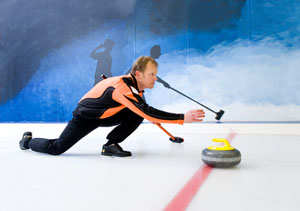Curling - born in Europe, popular sport in Canada today
The precise beginnings of curling will always remain a mystery! However, it is not hard to imagine a man, hundreds or even thousands of years ago, who weighed a smooth, heavy rock in his hand, then watched and listened with fascination as he launched it along a glistening bed of ice on a frozen river. This "first curler" must have been intrigued by the way the rock moved and by the grumbling sound it made as it twisted and turned. Other people in the not so distant past have heard this same sound and have applied it as a nickname for the game of curling ... it is often referred to as "the roaring game".
Scots and continental Europeans have engaged in many a lively dispute as to the true origin of curling. Both claim to be founders. Did Scots invent the game, or was it imported by Flemish sportsmen who emigrated to Scotland during the reign of James VI (James I of England)? Did Europeans engage in some early form of curling, and did Scots merely adopt and enhance it? The evidence, based on works of art, contemporary writings, and archaeological finds, has sparked a number of theories, but nothing is conclusive.
Some of the earliest graphic records of a game similar to curling date from 1565. Two oil paintings by the Dutch master Pieter Bruegel, entitled "Winter Landscape with Skaters and a Birdtrap" and "Hunters in the Snow", show eisschiessen or "ice shooting", a Bavarian game played with a long stick-like handle, that is still enjoyed today. Another work, an engraving by R. de Baudous (1575 - 1644) after N. van Wieringen, entitled "Hyems" or "Winter", shows players who appear to be sliding large discs of wood along a frozen water-way. Other sketches from around the same time show a Dutch game called kuting, played with frozen lumps of earth.
The first hand-written record of what could be called an early curling game dates from February, 1540, when John McQuhin of Scotland noted down, in Latin, a challenge to a game on ice between a monk named John Sclater and an associate, Gavin Hamilton.
The first printed reference to curling appears in a 17th century elegy published by Henry Adamson, following the death of a close friend: His name was M. James Gall, a citizen of Perth, and a gentle-man of goodly stature, and pregnant wit, much given to pastime, as golf, archerie, curling and jovial companie. It seems too that the game tempted many people from all walks of life. Records from a Glasgow Assembly of Presbyterians in 1638 accused a certain Bishop Graham of Orkney of a terrible act: He was a curler on the ice on the Sabbath.
By the 18th century, curling had become a common past-time in Scotland. Both the poetry and the prose of the era provide numerous records of bonspiels, curling societies, and curling as a great national game.
The real controversy over the birthplace of the game was initiated by the Reverend John Ramsay of Gladsmuir, Scotland. In his book, An Account of the Game of Curling (Edinburgh 1811), he argued in favor of Continental beginnings. His research into the origins of curling words (examples: bonspiel, brough, colly, curl, kuting, quoiting, rink, and wick), led him to conclude that they were derived from Dutch or German. Claiming that most of the words were foreign, he wrote, but the whole of the terms being Continental compel us to ascribe to a Contintental origin.
The famous historian, the Reverend John Kerr contested Ramsay's views and campaigned in favor of Scottish beginnings to curling. In A History of Curling (1890), Kerr questioned: if Flemings had brought the game to Scotland in the 1500's, why did Scottish poets and historians make no special mention of its introduction before 1600?. He also saw no proof that many of the terms were Continental, explaining that many were of Celtic or Teutonic origin (examples: channel stone, crampit, draw, hack, hog, skip, tee, toesee, tramp, and tricker).
To add to the puzzle, archaeological evidence of a curling stone (the famous Stirling Stone) inscribed with the date 1511 turned up, along with another bearing the date 1551, when an old pond was drained at Dunblane, Scotland.
The true origin of curling is cloudy, lost in time. There is no doubt or dispute, however, that the Scots nurtured the game. They improved equipment, established rules, turned curling into a national past-time, and exported it to many other countries throughout the world.
